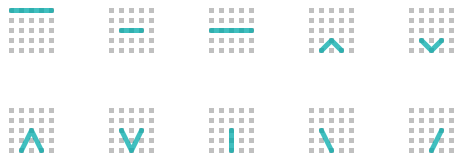Procedural generation of triangular glyphs

Some triangular glyphs
Some days ago I randomly ended into the subreddit on Procedural generation, which I didn’t suspect existed. In specific, I ended up into the monthly challange of March 2017.
As you can see there, the challenge was on generating a set of runes, glyphs, or symbols. I found the challenge very interesting and starting from one of the pictures they reference (this one) I decided to create my own generator as an excuse to learn a bit of Haxe and OpenFL.
I focused on the gliphs with triangular forms, the ones called “actions” in the reference picture. I first sifted the gliphs from the figure in order to have a more clear picture of the type of triangular gliphs I wanted to create. So, I removed “connect” and “reflect” since they broke the pyramidal structure of the other ones. I also sifted “learn”, “understand”, and “protect”, because they added two new elements (the circle and the dot) that I dislike.
I started by placing a triangle in a matrix of 5x5 dots. Then I assigned a probability of 0.9 to a close-base triangle and a probability of 0.1 to an open-base triangle.

Outline of triangle glyphs
With the border already working, I dissected the original glyph and obtained ten small pieces with which to generate the filling of the triangle to create a glyph. I assigned the same probability, to each piece, to be part of the final glyph.

Content of triangle glyphs
After many tests, I decided to impose some rules to avoid the creation of overcharged glyphs:
- A glyph will have a maximum of a border and three pieces with a probability of 0.6 to have a single piece, 0.3 for two pieces, and 0.1 for three pieces.
- Each part can only be included once (I know, this one is obvious).
- When added any diagonal lines none of the following pieces can be added (and vice versa): (small) happy face, (small) sad face, leg (line in the middle), (large) sad face, nor any diagonal.
- When added (small) sad face we cannot add a large sad face (and vice versa).
- Beltline (horizontal midline within the triangle) cannot be combined with the lance line (horizontal midline across the triangle).
- Ceiling (horizontal line on the top of the glyph) and lance cannot be combined.
With these rules in place, I liked the type of glyphs obtained from the random generation.
The last part was to decide the colors to use as background and for the glyphs. I went for a old-paper color as background and some old-ink colors for the glyphs:
- paper:
0xfff8bd - pink salmon:
0xf78bc1 - cloud blue:
0xafd8df - ink blue:
0x000f55

Colors for triangular glyphs
The final piece can be seen in my dashboard at itch (just look for “Triangle Glyphs”). The small web application allows you to generate a wall with 30 randomly generated glyphs, an alphabet with 25 unique glyphs, and to see the pieces used to create all of them.
The code is available at GitHub.